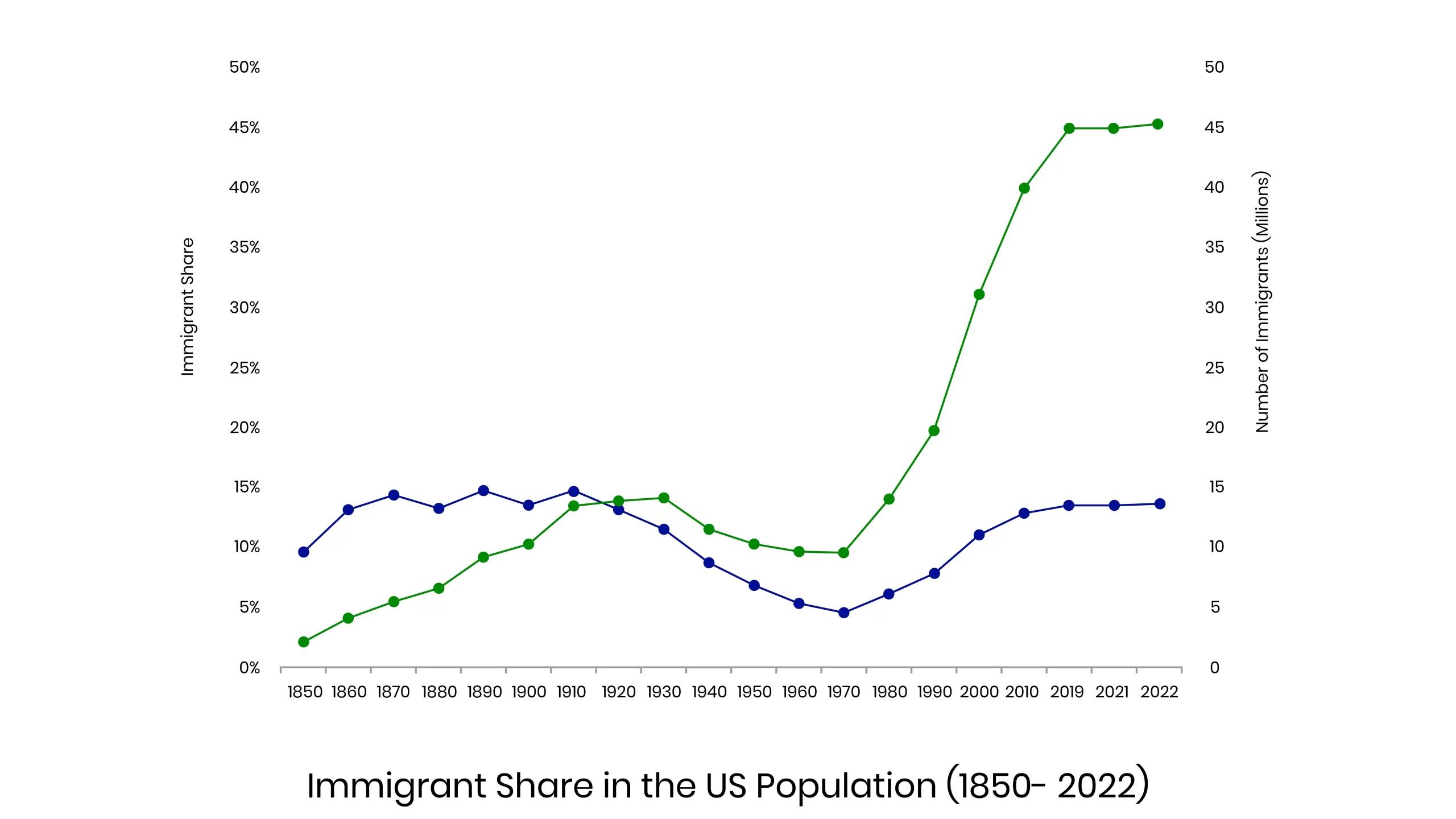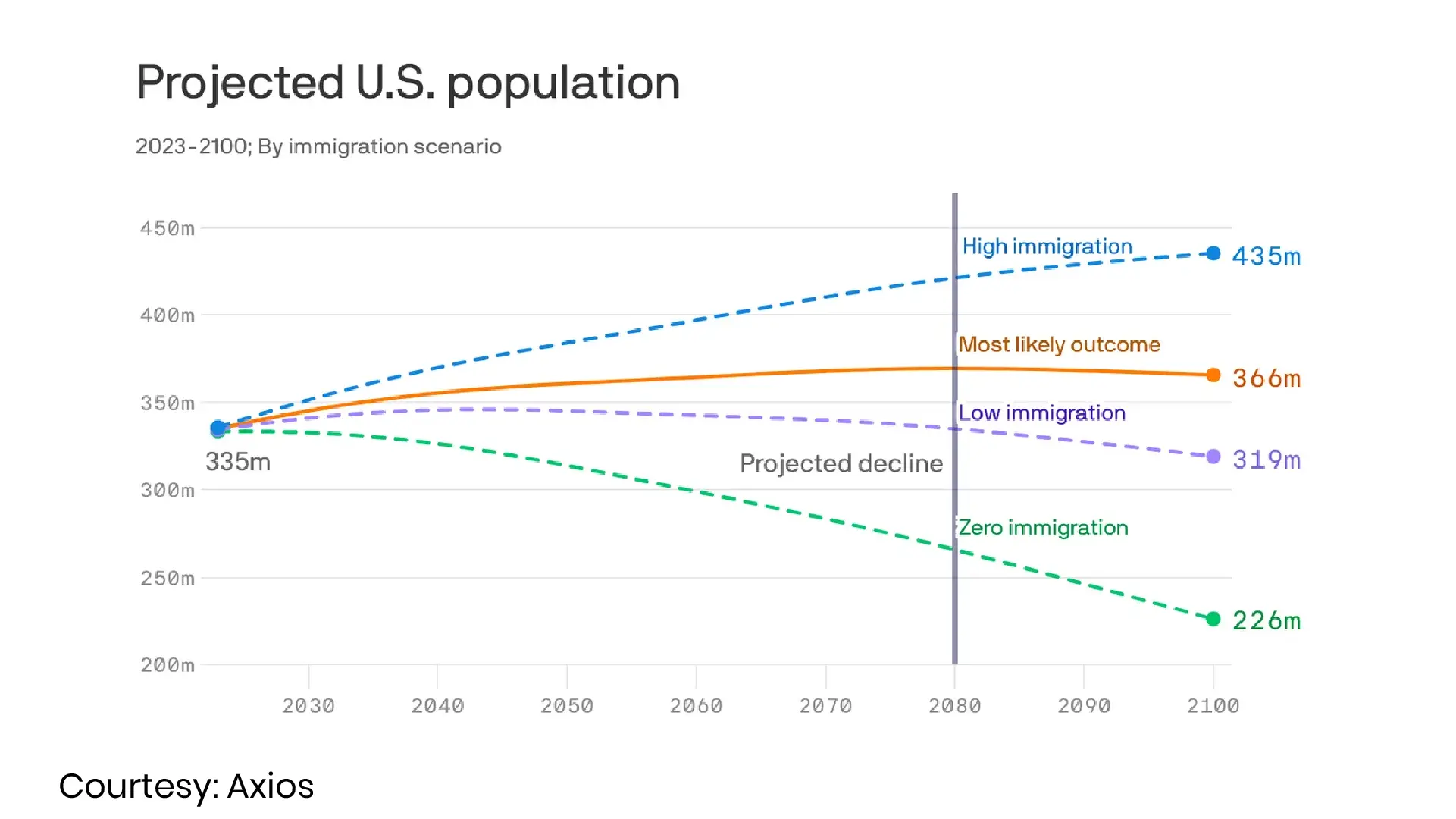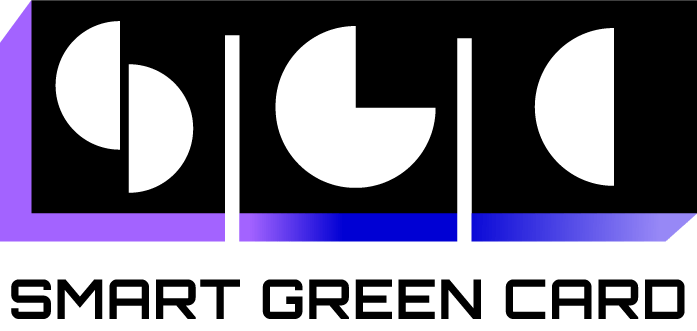Economic Catalysts: How Immigrants in US Drive Innovation and Growth

Table of Contents
America stands proudly as one of the world’s leading economies.
Numerous research studies consistently highlight the invaluable role of immigration in bolstering the US economy, addressing workforce gaps, and enhancing US competitiveness on the global stage.
Despite being a vibrant contributor to prosperity, immigration remains a topic of discussion in the US, occasionally clouded by misconceptions such as the notion that immigrants in US are displacing American workers.
To shed light on the positive impact of immigrants, let’s explore their crucial role in the US economy, backed by compelling research findings.
Who are Immigrants?
Individuals residing in a country other than their country of birth are called immigrants.
They relocate to a new country for various reasons, such as education, employment opportunities, family reunification, and other environmental factors.
In the U.S., legally, individuals who have obtained permanent status to live and work freely in the country are classified as immigrants, while those who come to the U.S. for a temporary stay for purposes such as work, education, business trips, etc., are known as non-immigrants.
Furthermore, individuals with immigrant status often have different rules to follow based on their legal status.
Immigrant Share in the US Population
To gain a comprehensive understanding of the immigrant population in the United States, let’s analyze the statistical data reports analyzed by the Migration Policy Institute.
- As of 2022, there were approximately 45 million immigrants residing in the US, indicating that one in 8 Americans is an immigrant.
- In 2022, immigrants in US accounted for nearly 13.9% of the US population, representing a significant increase since 2017 when it remained the same.
- According to this report, most immigrants come from Latin America and Asia. The majority of new immigrants hold a bachelor’s degree or an advanced degree, breaking the myth that most immigrants are low-skilled and need government support to live in the US.
- In 2022, Indian and Chinese immigrants in US comprised 6% of the immigrant US population, totaling nearly 28.3 lakhs of people.
- Mexican immigrants remained the top group among other countries and accounted for 23% of the US immigrant population. However, this figure decreased by 1% compared to the previous year’s statistical report.
In this report, immigrants include both people who are legally and illegally residing in the US. However, the Pew Research Center’s recent report states that 10.5 million are unauthorized immigrants, which is 22%, and legal immigrants share nearly 36 million, which is 78%.

4 Ways Immigrants Play a Crucial Role in the U.S. Economy

1. Addressing Labor Shortages
Let’s explore the insights from the American Immigration Council’s annual analysis report, ‘Map the Impact: Immigrants Constitute Over 18% of the Total U.S. Population Growth,’ to understand how immigrants in US contribute to filling gaps in the U.S. workforce.
In 2021, 78% of the U.S. workforce comprised immigrants, with 61.4% being U.S. nationals.
Consequently, 17% of the active U.S. working population is foreign-born. The immigrants in US play a vital role in not only filling the void left by the baby boomers but also addressing labor force shortages.
Foreign-born individuals are employed across various sectors in the US. They represent a significant share of more than 15% of the workforce in healthcare, education, construction, and other professional services.
In 2021, immigrants filled at least 50% or more of positions in a few job occupations, including taxi drivers, crop graders, stucco craftsmen, drywall finishers, pedicurists, and manicurists.
Furthermore, in 2021, 22.8% of workers in STEM fields in the US were immigrants, totaling approximately 2.7 million individuals.
STEM workers are crucial for the US to maintain competitiveness in the global tech industry.
The main benefit of economic immigrants is that they act as job multipliers; their employment makes it easier for other people to enter the workforce and contributes to the growth of the economy.
2. Entrepreneurship
Immigrant entrepreneurs are major contributors to the US economy.
Let’s delve into the recent report to understand how immigrants in US play a pivotal role in the business space:
According to the New American Forbes 500 companies report in 2023, 44.8% were founded by immigrants or their children.
This means that 224 new American companies on the Fortune 500 list were founded by immigrants, generating $8.1 trillion in GDP in the fiscal year 2022.
Moreover, the report states that the GDP produced by these new American companies is higher than the GDP of developed countries such as Japan, Germany, and the United Kingdom.
Based on this report, each new American company has, on average, 66,192 employees and employs 14.8 million people worldwide.
Some of the notable immigrant entrepreneurs in the US are Sergey Brin (Google), Elon Musk (SpaceX, Tesla), and Jean-Luc Vaillant (LinkedIn).
Thus, immigrants play a vital role in job creation and strengthening the US economy.
3. Contribution to the Economy
According to the Bureau of Economic Analysis in 2021, immigrants in US contribute 17% of the country’s GDP.
Thus, the economic output in 2021 was $19.6 trillion, with $3.3 trillion contributed by foreign-born individuals.
Here are a few more facts about how immigration contributes to the US economy, based on the Immigration Research Initiative report:
- There is a common misconception that most immigrants in the US are low-skilled. On the contrary, 65% of immigrants’ jobs are medium-waged jobs, earning at least $35,000 per year.
- Immigrants also occupy a 58% share in production jobs, which are low-wage jobs such as cooks, cleaners, and meat processors. However, these services are crucial in Americans’ daily lives.
Apart from all these facts, the recent Bipartisan Policy Center report estimates that currently, 7.6 million immigrants in US are in backlogs, including new potential immigrants and those who are already in the US on temporary status.
The report clarified that allowing those people in backlogs to adjust their status in the US will contribute to a $3.9 trillion GDP over decades.
In conclusion, immigrants are great assets to the US economy.
4. Immigrants in US Drive More Innovation
According to a study by the National Bureau of Economic Research, immigrants are more likely to drive innovation compared to their counterparts. Some key findings include:
- Immigrants in US constitute 16% of the country’s inventors, representing a 23% share of patents issued from 1996 to 2016.
- Patents granted to economic immigrants were highly significant in their respective fields and carried substantial economic value.
- The immigrants are also assisting their colleagues in innovating and enhancing productivity.
Importance of Highly Skilled Immigrants in US
According to the US Census Bureau, three out of four US-born students in STEM fields will transition to different fields.
On the contrary, half of the immigrant students opt for STEM courses, and more than one-third obtain doctorates in science and engineering. Most international students aspire to stay and work in the US after graduation.
Therefore, the highly skilled immigrants jobs in STEM fields are crucial for upholding leadership in STEM disciplines.
This is essential not only for national security but also for sustaining competitiveness compared to China.
US Census Bureau Report 2023 on Population Projections in the US
The recently released U.S. Census Bureau Report for 2023 provides a compelling narrative on how immigration is shaping the future of the United States, acting as both a catalyst for population growth and a driver of economic prosperity.
The analysis is based on four immigration scenarios; let’s explore each of them.
Begin by examining the Population Projections for 2022-2100 across four immigration scenarios. The estimated population in the U.S. for 2022 is 333 million people.
- Under the High immigration scenario, the projected U.S. population is 435 million (+30.6%) in 2100.
- In the Main immigration scenario, the U.S. population is projected to be 366 million (+9.9%) in 2100.
- In the Low immigration scenario, the U.S. population is projected to be 319 million (-4.3%) in 2100.
- Under the Zero immigration scenario, the U.S. population is projected to be 226 million (-32.2%) in 2100.
Additionally, familiarize yourself with the four immigration scenario standards established by the U.S. Bureau for analysis:
- High immigration: Reflects recent achievements, with an annual net immigration of 1.5 million people.
- Main immigration: Aligned with recent historical trends, excluding pre and post-periods.
- Low immigration: Based on patterns observed in the latter years of the Trump administration.
- Zero immigration: Assumes no migration or out-migration, serving as a benchmark.

Key Census Findings
- Youth and Seniors Shift: Interestingly, high immigration results in a lower percentage increase in the senior age population compared to the other three immigration scenarios. This is primarily due to the younger age of the immigrants in the US, which slows down the aging process.
- Working-Age Dynamics: The 18-24 working-age population experiences positive growth in high immigration scenarios but faces declines in low and zero immigration scenarios.
Conclusion
Immigrants in US play a crucial role in economic growth and maintaining global competitiveness. However, the most common immigration path for highly skilled immigrants is the H-1B route, allowing them to work legally in the US.
The H-1B visa system selects candidates randomly for assessment, and its annual cap limit is significantly lower than the number of visa applicants.
Furthermore, high-skilled immigrants face long backlogs if they apply for a green card in the EB2 and EB3 categories, with delays extending for decades.
Notably, the EB1A green card is a better option for high-skilled immigrants in the US, as it offers faster processing, and the final action dates advance more quickly than those in the EB2 and EB3 categories.
For those seeking practical assistance in developing their EB1A profile and navigating the process of obtaining the EB1A green card, the Smart Green Card Program offers valuable support.
It is high time for the US to proactively implement comprehensive changes in its immigration policy, not only to attract and retain tech talents but also to ensure sustained global competitiveness.
Want to learn more about your best pathway to a Green Card? Visit Smart Green Card for expert guidance and proven strategies.
- SGC
- No Comments
Latest blog & Newsletters
May 2025 Visa Bulletin Predictions: What to Expect for EB1, EB2 & EB3
May 2025 Visa Bulletin Predictions: What to Expect for EB1, EB2 & EB3...
Smart Green Card: Expert Guidance for Your U.S. Visa & Green Card Journey
Smart Green Card: Expert Guidance for Your U.S. Visa & Green Card Journey...
H1B Lottery Results 2025: Everything You Need to Know
H1B Lottery Results 2025: Everything You Need to Know The H1B visa lottery...





